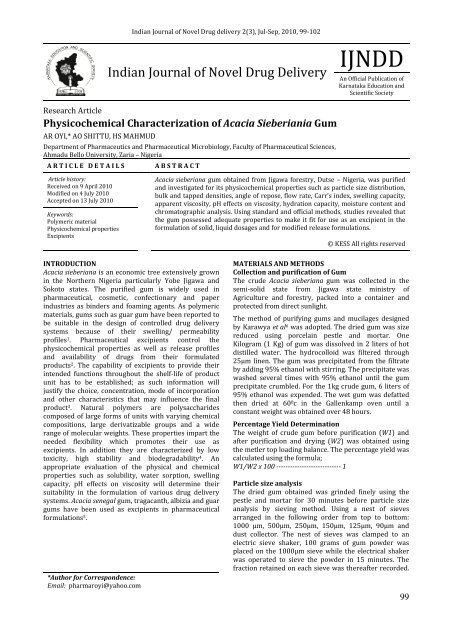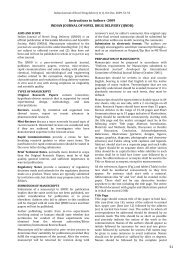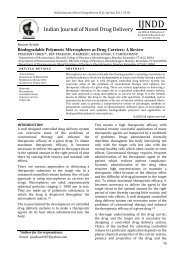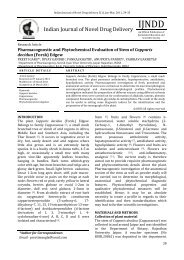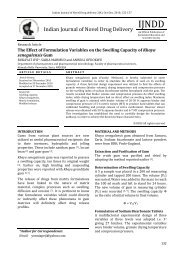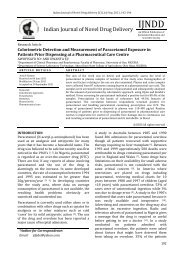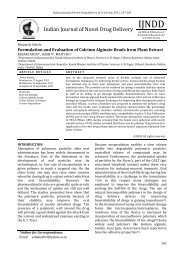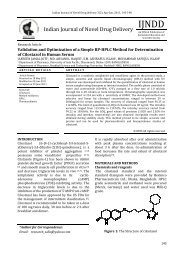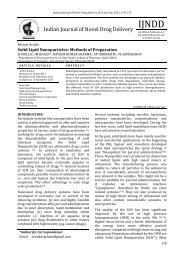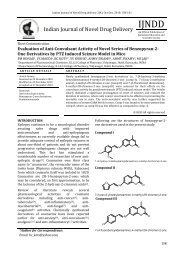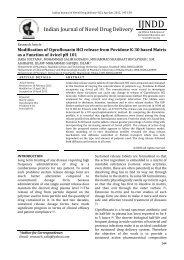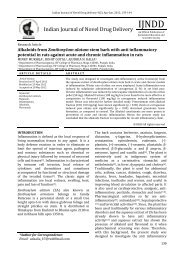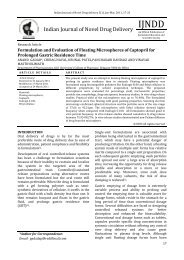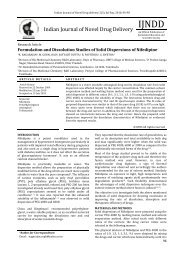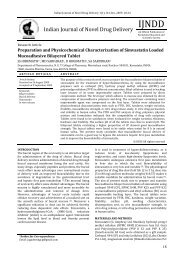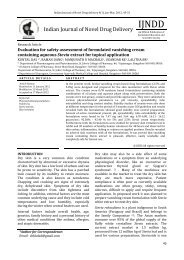Physicochemical Characterization of Acacia Sieberiania Gum
Physicochemical Characterization of Acacia Sieberiania Gum
Physicochemical Characterization of Acacia Sieberiania Gum
You also want an ePaper? Increase the reach of your titles
YUMPU automatically turns print PDFs into web optimized ePapers that Google loves.
Indian Journal <strong>of</strong> Novel Drug delivery 2(3), Jul-Sep, 2010, 99-102<br />
Indian Journal <strong>of</strong> Novel Drug Delivery<br />
IJNDD<br />
An Official Publication <strong>of</strong><br />
Karnataka Education and<br />
Scientific Society<br />
Research Article<br />
<strong>Physicochemical</strong> <strong>Characterization</strong> <strong>of</strong> <strong>Acacia</strong> <strong>Sieberiania</strong> <strong>Gum</strong><br />
AR OYI,* AO SHITTU, HS MAHMUD<br />
Department <strong>of</strong> Pharmaceutics and Pharmaceutical Microbiology, Faculty <strong>of</strong> Pharmaceutical Sciences,<br />
Ahmadu Bello University, Zaria – Nigeria<br />
A R T I C L E D E T A I L S<br />
A B S T R A C T<br />
Article history:<br />
Received on 9 April 2010<br />
Modified on 4 July 2010<br />
Accepted on 13 July 2010<br />
Keywords:<br />
Polymeric material<br />
<strong>Physicochemical</strong> properties<br />
Excipients<br />
<strong>Acacia</strong> sieberiana gum obtained from Jigawa forestry, Dutse – Nigeria, was purified<br />
and investigated for its physicochemical properties such as particle size distribution,<br />
bulk and tapped densities, angle <strong>of</strong> repose, flow rate, Carr’s index, swelling capacity,<br />
apparent viscosity, pH effects on viscosity, hydration capacity, moisture content and<br />
chromatographic analysis. Using standard and <strong>of</strong>ficial methods, studies revealed that<br />
the gum possessed adequate properties to make it fit for use as an excipient in the<br />
formulation <strong>of</strong> solid, liquid dosages and for modified release formulations.<br />
© KESS All rights reserved<br />
INTRODUCTION<br />
<strong>Acacia</strong> sieberiana is an economic tree extensively grown<br />
in the Northern Nigeria particularly Yobe Jigawa and<br />
Sokoto states. The purified gum is widely used in<br />
pharmaceutical, cosmetic, confectionary and paper<br />
industries as binders and foaming agents. As polymeric<br />
materials, gums such as guar gum have been reported to<br />
be suitable in the design <strong>of</strong> controlled drug delivery<br />
systems because <strong>of</strong> their swelling/ permeability<br />
pr<strong>of</strong>iles 1 . Pharmaceutical excipients control the<br />
physicochemical properties as well as release pr<strong>of</strong>iles<br />
and availability <strong>of</strong> drugs from their formulated<br />
products 2 . The capability <strong>of</strong> excipients to provide their<br />
intended functions throughout the shelf-life <strong>of</strong> product<br />
unit has to be established; as such information will<br />
justify the choice, concentration, mode <strong>of</strong> incorporation<br />
and other characteristics that may influence the final<br />
product 3 . Natural polymers are polysaccharides<br />
composed <strong>of</strong> large forms <strong>of</strong> units with varying chemical<br />
compositions, large derivatizable groups and a wide<br />
range <strong>of</strong> molecular weights. These properties impart the<br />
needed flexibility which promotes their use as<br />
excipients. In addition they are characterized by low<br />
toxicity, high stability and biodegradability 4 . An<br />
appropriate evaluation <strong>of</strong> the physical and chemical<br />
properties such as solubility, water sorption, swelling<br />
capacity, pH effects on viscosity will determine their<br />
suitability in the formulation <strong>of</strong> various drug delivery<br />
systems. <strong>Acacia</strong> senegal gum, tragacanth, albizia and guar<br />
gums have been used as excipients in pharmaceutical<br />
formulations 5 .<br />
*Author for Correspondence:<br />
Email: pharmaroyi@yahoo.com<br />
MATERIALS AND METHODS<br />
Collection and purification <strong>of</strong> <strong>Gum</strong><br />
The crude <strong>Acacia</strong> sieberiana gum was collected in the<br />
semi-solid state from Jigawa state ministry <strong>of</strong><br />
Agriculture and forestry, packed into a container and<br />
protected from direct sunlight.<br />
The method <strong>of</strong> purifying gums and mucilages designed<br />
by Karawya et al 6 was adopted. The dried gum was size<br />
reduced using porcelain pestle and mortar. One<br />
Kilogram (1 Kg) <strong>of</strong> gum was dissolved in 2 liters <strong>of</strong> hot<br />
distilled water. The hydrocolloid was filtered through<br />
25µm linen. The gum was precipitated from the filtrate<br />
by adding 95% ethanol with stirring. The precipitate was<br />
washed several times with 95% ethanol until the gum<br />
precipitate crumbled. For the 1kg crude gum, 6 liters <strong>of</strong><br />
95% ethanol was expended. The wet gum was defatted<br />
then dried at 60 0 c in the Gallenkamp oven until a<br />
constant weight was obtained over 48 hours.<br />
Percentage Yield Determination<br />
The weight <strong>of</strong> crude gum before purification (W1) and<br />
after purification and drying (W2) was obtained using<br />
the metler top loading balance. The percentage yield was<br />
calculated using the formula;<br />
W1/W2 x 100 ---------------------------- 1<br />
Particle size analysis<br />
The dried gum obtained was grinded finely using the<br />
pestle and mortar for 30 minutes before particle size<br />
analysis by sieving method. Using a nest <strong>of</strong> sieves<br />
arranged in the following order from top to bottom:<br />
1000 µm, 500µm, 250µm, 150µm, 125µm, 90µm and<br />
dust collector. The nest <strong>of</strong> sieves was clamped to an<br />
electric sieve shaker, 100 grams <strong>of</strong> gum powder was<br />
placed on the 1000µm sieve while the electrical shaker<br />
was operated to sieve the powder in 15 minutes. The<br />
fraction retained on each sieve was thereafter recorded.<br />
99
AR Oyi et al / Indian Journal <strong>of</strong> Novel Drug Delivery Jul-Sep, 2010, 99-102<br />
Determination <strong>of</strong> Bulk and Tapped Densities<br />
Bulk and tapped densities were determined by modified<br />
method 7 . Sixty grams (60 g) <strong>of</strong> the acacia gum powder<br />
was weighed and transferred into a 100ml measuring<br />
cylinder the volume (Vb) was recorded as bulk volume.<br />
The total weight <strong>of</strong> the powder and cylinder was noted.<br />
The bottom <strong>of</strong> the cylinder was raised 17cms above the<br />
slab and made to fall on the platform continuously for<br />
100 taps. The volume (Vt) <strong>of</strong> the powder was recorded<br />
and this represents the volume <strong>of</strong> gum minus the voids<br />
and is called the tapped volume.<br />
Bulk density = 60/Vb ---------------------------------2<br />
Tapped density = 60/Vt ----------------------------- 3<br />
Angle <strong>of</strong> repose<br />
Angle <strong>of</strong> repose was determined as the tangent <strong>of</strong> the<br />
cone formed by powder heap. The height was divided<br />
by the radius formed by powder on passing through a<br />
funnel orifice to the horizontal 8 .<br />
Flow rate<br />
Thirty grams (30g) weight (w) <strong>of</strong> the gum powder was<br />
placed in the Erweka flow tester apparatus and allowed<br />
to flow through the formed orifice. The time taken (t) for<br />
all the powder to completely flow out was noted and<br />
flow rate was computed from;<br />
w/t ---------------------------------------------------- 4<br />
Swelling capacity<br />
The method <strong>of</strong> Bowen and Vadino 9 was adopted. Five<br />
grams (5g) <strong>of</strong> the gum powder was placed in a 120ml<br />
capacity measuring cylinder and tapped 200 times<br />
manually. The volume (Vt) was recorded and this was<br />
followed by the addition <strong>of</strong> 85ml <strong>of</strong> distilled water. The<br />
volume was made to 100ml and left to stand for 24hrs<br />
after which the new volume occupied by gum (Vv) was<br />
recorded. The swelling capacity (Φ) was computed as the<br />
ratio <strong>of</strong> final volume to initial volume.<br />
Φ = Vv/Vt --------------------------------------------- 5<br />
Hydration capacity<br />
This is also known as water retention capacity. One gram<br />
(1g) <strong>of</strong> gum powder was placed in a centrifuge tube and<br />
covered with 10ml <strong>of</strong> purified distilled water. The tube<br />
was manually shaken intermittently over 2hrs period<br />
and left to stand for 30mins. This was then centrifuged<br />
for 10mins at 3000rpm. The supernatant was decanted<br />
and the weight <strong>of</strong> the gum powder after water uptake<br />
and centrifugation was determined (Xg)<br />
Hydration capacity = Xg/1g -------------------- 6<br />
Determination <strong>of</strong> Apparent Viscosity<br />
One hundred millimeter (100ml) mucilages <strong>of</strong> gum<br />
samples were prepared at concentrations <strong>of</strong> 10, 20 and<br />
30%w/v. The apparent viscosity <strong>of</strong> each concentration<br />
was determined using Brookfield Synchro-letric<br />
viscometer (model RUT). The instrument was operated<br />
by immersing the spindle in the mucilage. When set in<br />
motion, it is opposed by a viscous drag which is detected<br />
and registered as a deflection in the recorder.<br />
The effect <strong>of</strong> different shear rates <strong>of</strong> 10, 20, 50 and<br />
100rpm were determined for each <strong>of</strong> the concentrations<br />
used.<br />
Effects <strong>of</strong> pH on Viscosity <strong>of</strong> Mucilage<br />
Mucilages <strong>of</strong> different pH values <strong>of</strong> 1, 3, 5, 7, 9, 11 and 13<br />
were prepared using 0.1M HCl and 0.1M NaOH. The pH<br />
values were determined using Oalkon pH meter (model<br />
1100) at room temperature <strong>of</strong> 28 0 c. These mucilages <strong>of</strong><br />
different pH values were subjected to varying shear<br />
stresses to elucidate any rheological changes.<br />
Chromatographic Analysis<br />
Preparation <strong>of</strong> sample: To one gram <strong>of</strong> gum were<br />
added 10ml <strong>of</strong> purified water and 10ml <strong>of</strong> 7% sulphuric<br />
acid and mixture refluxed for 3hrs in a water bath, five<br />
milliliters (5ml) <strong>of</strong> water was subsequently added and<br />
extracted with ethyl acetate. Barium Carbonate powder<br />
was subsequently added to the supernatant layer<br />
containing the sulphate ions and filtered. The filtrate was<br />
concentrated on a water bath. The residue was dried<br />
over activated silica gel placed in desiccators. This was<br />
weighed and used for chromatographic analysis.<br />
Paper chromatographic studies: Seven percent weight<br />
per volume (7% W/V) <strong>of</strong> the hydrolysed sample above<br />
and the reference sugar samples rhammose, xylose,<br />
sucrose, arabinose, mannose, ribose and fructose<br />
were used. Using whatman no. 1 chromatographic<br />
paper and a capillary tube all the known sugars solutions<br />
and that <strong>of</strong> the sample were spotted on the paper and left<br />
to dry. The chromatogram was developed using the<br />
descending technique for 30hours.The solvent system<br />
used was n-butanol: acetic acid: water in the ratio 4:1:5.<br />
After the expiration <strong>of</strong> the exposure period, the<br />
chromatogram was air dried and activated in an oven at<br />
a temperature <strong>of</strong> 40 0 c and then sprayed with aniline<br />
phthalate solution. The level <strong>of</strong> each sugar in respect to<br />
the references were marked and recorded.<br />
Moisture Content<br />
The moisture content (MC) <strong>of</strong> the purified gum was<br />
determined by weighing 100gram <strong>of</strong> the powder after<br />
which it was heated in an oven at a temperature <strong>of</strong> 105 0 c<br />
until a constant weight was obtained. The moisture<br />
content was then calculated using the following formulae<br />
MC = 0 ---------------------------- 7<br />
where Wt and W0 represent the weight <strong>of</strong> acacia gum<br />
after time “t” and the initial weight before heating<br />
respectively.<br />
RESULTS<br />
Percentage yield<br />
The weight <strong>of</strong> purified gum obtained from crude gum<br />
was found to be 830grams.<br />
% yield = [830/1000] x 100 = 83%<br />
Particle analysis<br />
Figure 1 depicts the percentage weight <strong>of</strong> powder<br />
retained on each size and the various factors. A high<br />
percentage <strong>of</strong> powder was retained on the 250µm size;<br />
therefore mean particle size fraction is 250-500µm.<br />
<strong>Physicochemical</strong> tests - The results <strong>of</strong> all these tests are<br />
displayed on Table 1.<br />
100
AR Oyi et al / Indian Journal <strong>of</strong> Novel Drug Delivery Jul-Sep, 2010, 99-102<br />
60<br />
50<br />
Identified sugar monomers <strong>of</strong> <strong>Acacia</strong> sieberiana gum<br />
were found to be rhamnose, galactose, arabinose, xylose<br />
and fructose.<br />
% Composition<br />
40<br />
30<br />
20<br />
10<br />
0<br />
0 - 75 75 - 90 90 - 125 125 - 150 150 - 250 250 - 500 500 - 1000<br />
Particle Size (µm)<br />
Figure 1: Particle Size Distribution <strong>of</strong> <strong>Gum</strong><br />
Table 1: <strong>Physicochemical</strong> properties <strong>of</strong> gum<br />
Parameters<br />
Color<br />
Odor<br />
Taste<br />
Moisture content<br />
Swelling capacity<br />
Hydration capacity<br />
Angle <strong>of</strong> repose<br />
Hausner’s ratio<br />
Bulk density<br />
Tapped density<br />
Carr ’ s index<br />
Flow rate<br />
Values<br />
<strong>of</strong>f-white<br />
odorless<br />
bland<br />
6.1%<br />
2.0<br />
1.66<br />
28.1 0<br />
1.145<br />
0.794<br />
0.909<br />
18%<br />
6.67g/s<br />
Figure 2: Effect <strong>of</strong> shear rate on the viscosity <strong>of</strong> gum at<br />
different concentrations<br />
DISCUSSIONS<br />
The percentage yield <strong>of</strong> the gum from the crude was<br />
found to be 83%. This implies that non-gum constituents<br />
and contaminants constitute about 17% <strong>of</strong> the crude.<br />
This yield is high in view <strong>of</strong> the fact that it was collected<br />
as scraps from the dried bark exudates.<br />
The particle size distribution is skewed to the right<br />
giving mean particle fraction <strong>of</strong> 250 - 500 µm. The<br />
particle size fraction <strong>of</strong> 250-500µm constitute about<br />
51% <strong>of</strong> the bulk powder while 10% were fractions<br />
greater than 500µm and 39% was between 75-250µm.<br />
The Carr’s index <strong>of</strong> the gum powder was 18% meaning a<br />
better chance <strong>of</strong> volume reduction due to higher<br />
compressibility index and it is an indication <strong>of</strong> better<br />
flow for the particles <strong>of</strong> the gum which were on the high<br />
side. The swelling capacity <strong>of</strong> 2; signifies the hydrophilic<br />
nature <strong>of</strong> gum. This implies that the gum has the capacity<br />
to swell into a gelatinous material from which any<br />
embedded drug could be released. The rheological<br />
investigation <strong>of</strong> gum reveals a shear thinning, non-<br />
Newtonian flow behavior and an increase in viscosity<br />
with increased concentration. This property will aid its<br />
function as a suspending agent. The hydration capacity<br />
<strong>of</strong> 1.66 shows that the gum retained 60% <strong>of</strong> its weight <strong>of</strong><br />
water in less than 3 hrs, therefore water penetration is<br />
rapid and could also potentiate the action <strong>of</strong><br />
disintegrants in tablets. The effect <strong>of</strong> pH on viscosity <strong>of</strong><br />
acacia mucilage was found to be insignificant at p > 0.5;<br />
therefore its use in matrix tablet formulation would not<br />
affect the bioavailability <strong>of</strong> incorporated drug at any<br />
region <strong>of</strong> the gastrointestinal tract. The results <strong>of</strong> the<br />
bulk and tapped densities indicates the volume<br />
reduction due to packing under applied tapped<br />
pressure, the regular shape, smooth texture, promoted<br />
closer packing <strong>of</strong> particles. The Hausner’s ratio and<br />
Carr’s index previews the degree <strong>of</strong> densification that<br />
would occur during tabletting. As the values <strong>of</strong> the<br />
indices increase the flow <strong>of</strong> powder decreases 10 giving<br />
more likely hood for weight variation. The sugars<br />
present were rhamnose, galactose, arabinose, xylose and<br />
fructose. A moisture content <strong>of</strong> 6.1% at 28 0 C is very high<br />
and as such moisture sensitive drugs should be packaged<br />
in well protected packages to prevent spoilage.<br />
CONCLUSION<br />
The characteristics <strong>of</strong> the gum have shown that it<br />
provides potentials for use as disintegrants and hydrogel<br />
in modified release dosage forms. The rheological<br />
properties <strong>of</strong> <strong>Acacia</strong> sieberiana gum also provides a basis<br />
for its use as a suspending and emulsifying agent due to<br />
the pseudo plastic and thixotropic flow pattern. In view<br />
<strong>of</strong> its high moisture uptake caution should be exercised<br />
in utilizing it as an excipient for moisture sensitive drugs<br />
and should be stored in airtight containers with handy<br />
desiccants.<br />
Figure 3: Effect <strong>of</strong> pH Changes on Viscosity <strong>of</strong> <strong>Gum</strong><br />
Chromatographic analysis Result<br />
101
AR Oyi et al / Indian Journal <strong>of</strong> Novel Drug Delivery Jul-Sep, 2010, 99-102<br />
REFERENCES<br />
[1] Monfere Bamba, F. Puixeux, J.P Marty and J.T<br />
Cartensen (1979). Release mechanisms in gel<br />
forming sustained releax preparations. International<br />
J. <strong>of</strong> Pharmaceutics 2 (1979) 307-315<br />
[2] Ram Mahato (2004). Dosage forms and drug<br />
delivery systems 37(40)<br />
[3] EMEA 2004 –European Medicines Agency ICH Q8<br />
Pharmaceutical Development (2004):4 -5.<br />
[4] Anekant J, Yashwant and Saiyai K.J. (2007).<br />
Properties <strong>of</strong> Biodegradable National<br />
Polysaccharides for the specific drug delivery to the<br />
colon. J. Pharm. Sci. (1) 86 -128<br />
[5] Martin A. Swarbrick J and Cammarata A. (1991) In:<br />
Physical pharmacy, 3 rd edition: 465 –544 -553.<br />
[6] Karawya, M.S, Balba, S.I and Af<strong>of</strong>i, M.S.A. (1971)<br />
Investigation <strong>of</strong> the carbohydrate content <strong>of</strong> certain<br />
mucilaginous plants. Planta Medica 20:14 – 23<br />
[7] Kunner Vand Kothan, S.H (1999). Effect <strong>of</strong><br />
compression force on the crystallinity <strong>of</strong> directly<br />
cellulose excipients. International Journal <strong>of</strong><br />
Pharmaceutics 177(2):173 -182<br />
[8] Jones T. M and Pilpel W (1996). The flow properties<br />
<strong>of</strong> granular magnesia J. pharmacol 1996; 18: 81 93.<br />
U.S.P (2003)<br />
[9] Bowen, F.E and Vadino, W.A (1984). A simple<br />
method for differentiating sources. Drug Dev.Ind.<br />
Pharm.10: 501 - 505<br />
[10] Stanifforth J.N. (1996) Powder flow. In:<br />
Pharmaceutics. The science <strong>of</strong> dosage from design<br />
.by Aulton, M. E, Churchill Livingston 600 -615<br />
102


